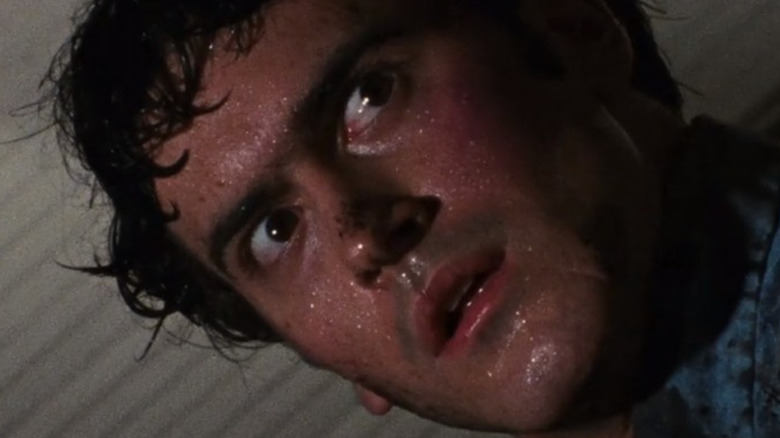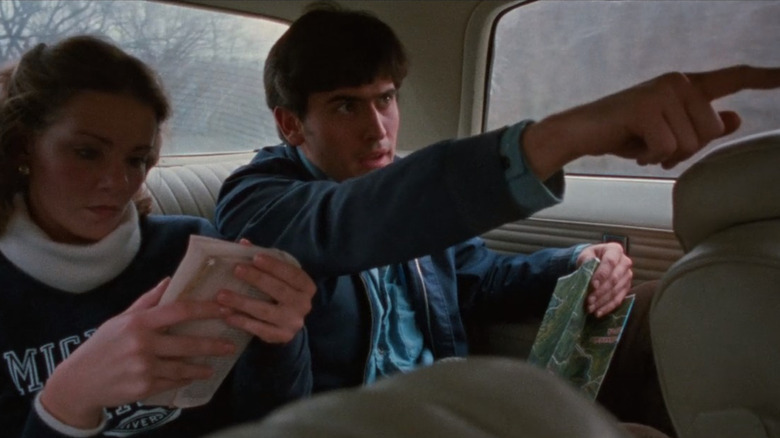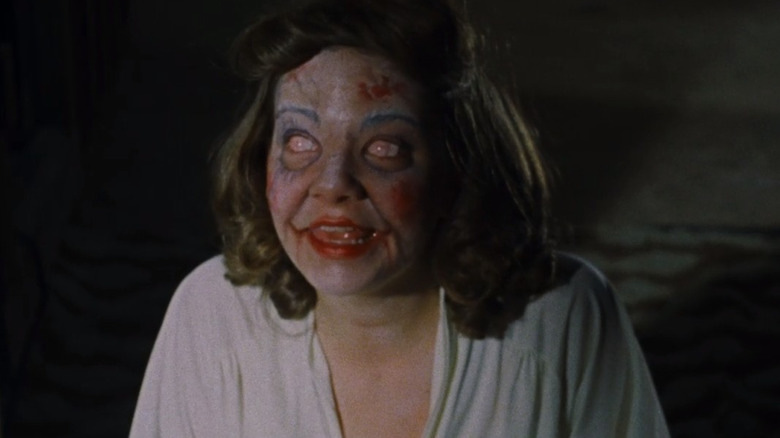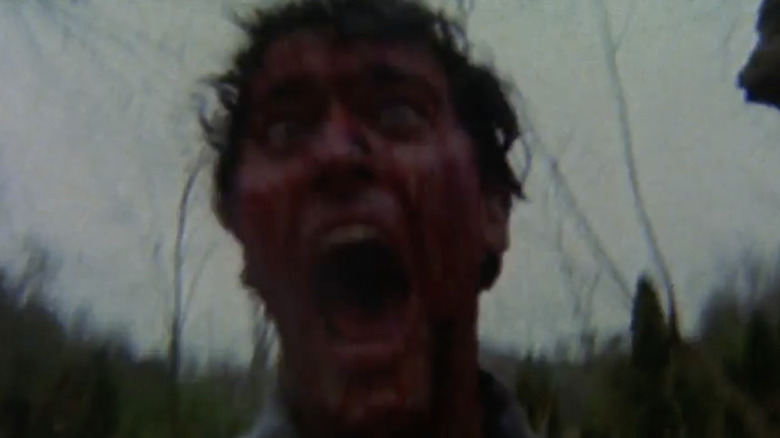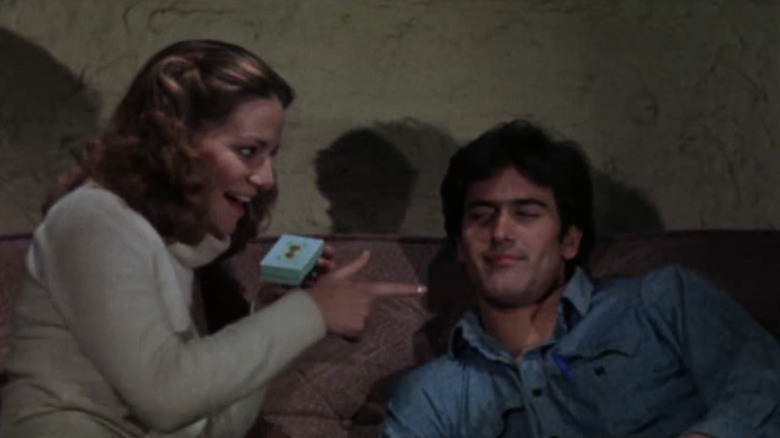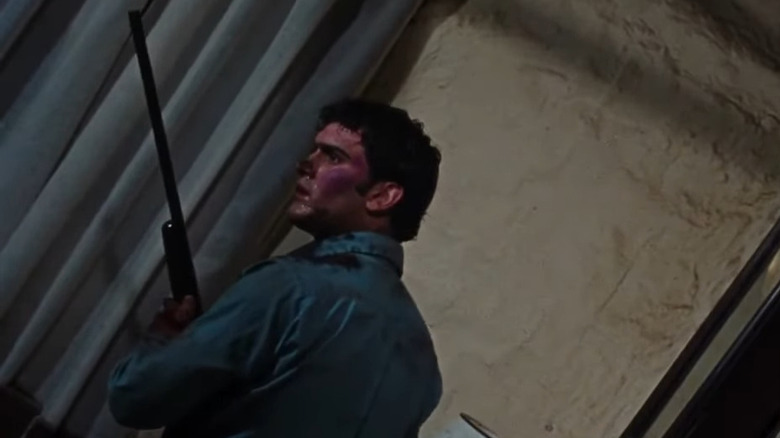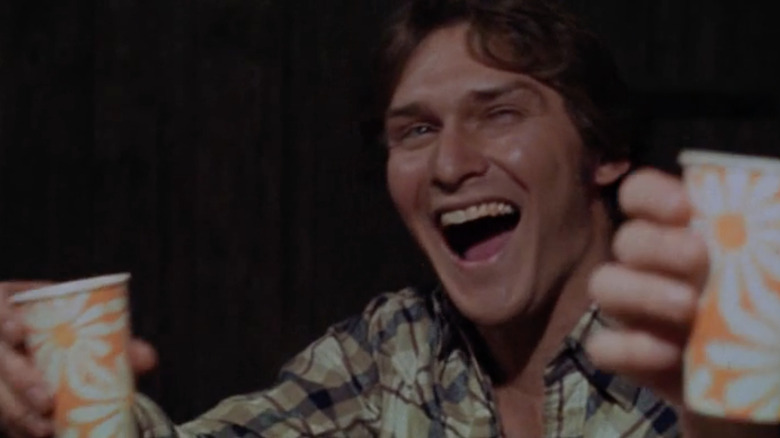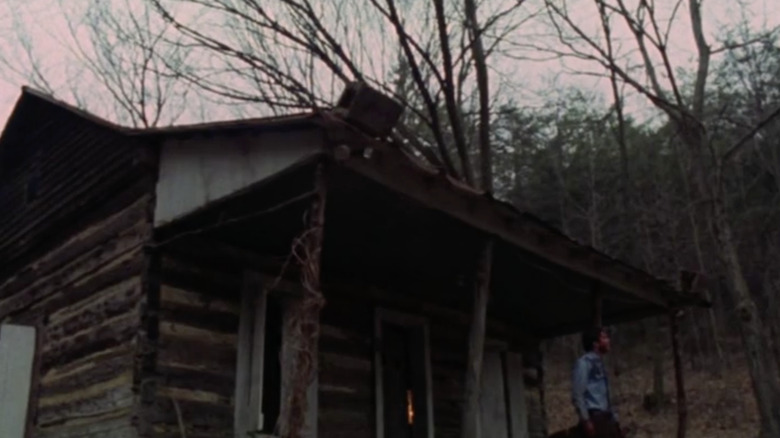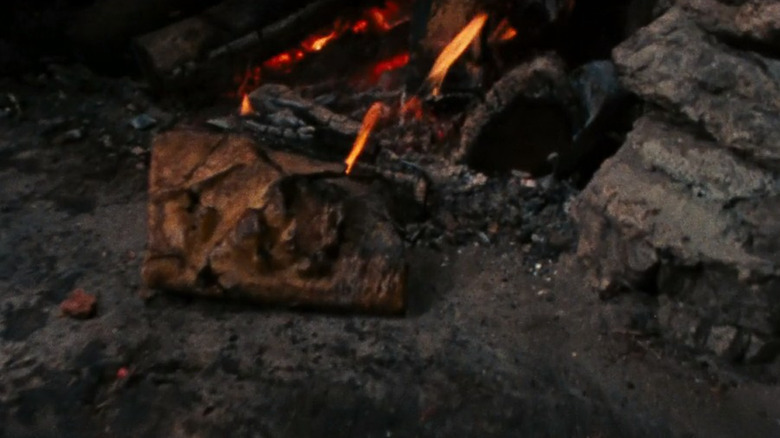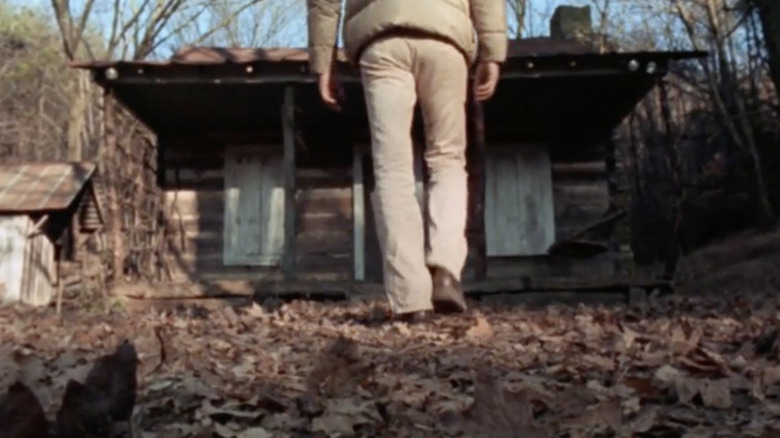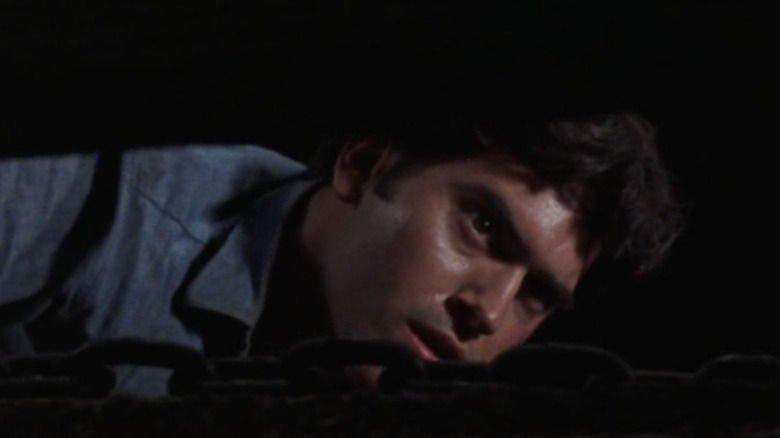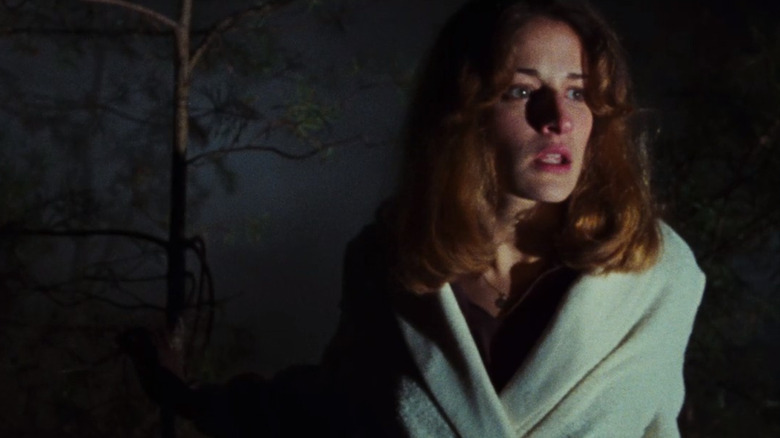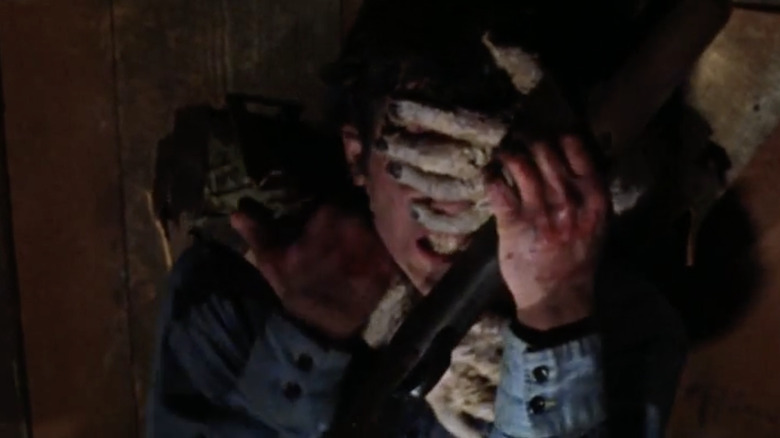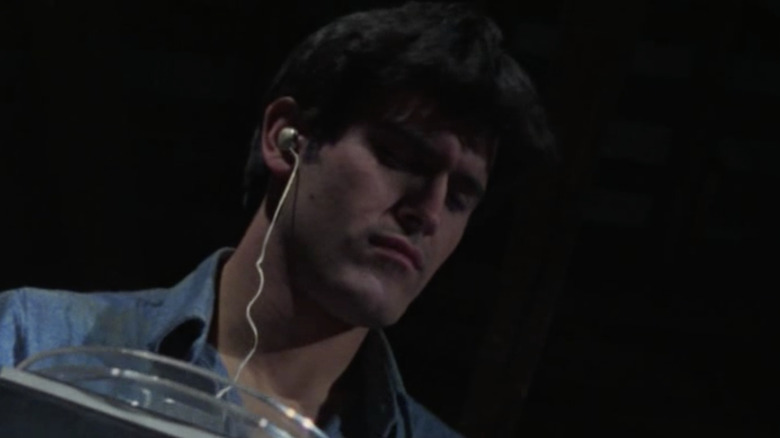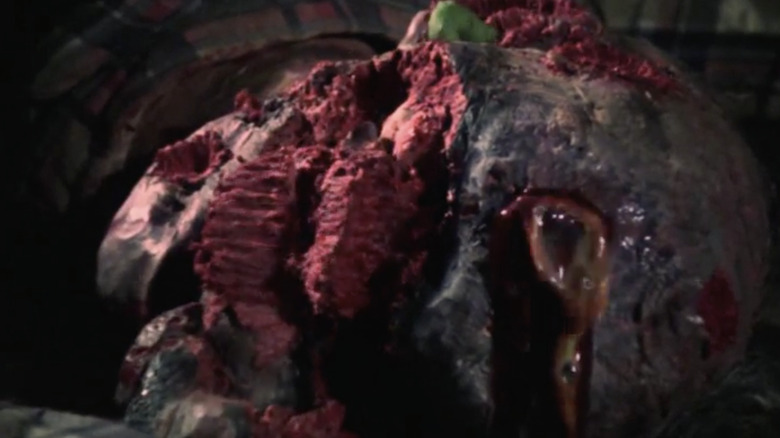Bizarre Things That Happened On The Set Of The Evil Dead
It's truly impossible to overemphasize the impact of "The Evil Dead." Sam Raimi's 1981 feature film debut is a benchmark of splatter cinema — a genuinely terrifying genre offering that also hints at Raimi's talents for physical comedy and kinetic cinematography. It's also the textbook example of what's possible with a camera, creativity, and a desire to make movies. Part of the mythic glow behind "The Evil Dead" is its presence as the impossible product of a bunch of pals making films on their own dime, in their own backyard, and evidently having a blast. It's scrappy as heck, and that's part of the film's appeal, both as a pillar of indie cinema and as a horror film.
While future entries in the series leaned far harder into Raimi's comedic talents, what makes "The Evil Dead" genuinely terrifying is a visceral quality, a sense that what you're watching is really playing out before your eyes. And, in a manner of speaking, you kind of are. A bunch of kids making a horror film in the woods? What could go wrong?
By all accounts, the process of making "The Evil Dead" was as grueling (and as entertaining) as the film itself. Like the hapless college kids in the film, the crew of "The Evil Dead" found themselves trapped in a remote cabin battling a never-ending volley of hardships. Just swap out demonic possession for rogue cattle and horrible weather. While many of the facts about the film's production have sublimated into the stuff of myth (and are to be taken with a big, chunky grain of salt), the film remains a veritable goldmine for behind-the-scenes appreciators. So, without further ado, here's a look at some of the most unbelievable, hilarious, and impressive things that took place on the set of "The Evil Dead."
Be warned — there are spoilers below.
The crew immediately got lost in the woods
Clocking in with a crisp runtime of 85 minutes, "The Evil Dead" wastes no time dropping audiences swiftly into the deep end. Not long after the spectral title card vanishes, we assume the perspective of a lurching steadicam — a POV shot that doesn't so much float as whip, careen, bob, and dive through the frigid marshland of the Tennessee backcountry. "Hey Ash, where are we?" asks Scott (Richard DeManincor) from behind the wheel. Their weekend getaway is already off to a bad start with the kind of uncertainty that defined road trips before smartphones took all the guesswork out of things.
As Bruce Campbell – executive producer/Sam Raimi BFF/Ash Williams himself — describes in his must-read autobiography "If Chins Could Kill: Confessions of a B Movie Actor," the on-screen disorientation had a real-life parallel. "Right from the get go, filming was a comedy of errors, or terrors, if you will," Campbell explains. "Within minutes of leaving for the first location, an abandoned bridge, the production van got lost, and we spent a half-hour trying to locate it. No sooner had we found it than Sam drove his 'Classic' into a ditch, and we had to get a tow truck to haul it out." As if that weren't enough of a bad omen, the crew then proceeded to hop into a cow field occupied by an "angry bovine," which proceed to chase director Sam Raimi "about a hundred yards" until he could scramble to safety.
The contact lenses were a real pain ... literally
The Deadites are some of the most iconic foes in horror history – ultra-violent, goopy, wise-cracking puppets for the evil occult force contained in the flesh-bound Necronomicon ex Mortis. While Deadites are distinguished by a laundry list of unsavory descriptors, from lurching limbs to cackling laughter, a sure-fire way to tell that your girlfriend has been possessed by evil is the blank, all-white eyes.
Sometimes, lucky actors simply had their eyelids painted white — as is the case when Betsy Baker's Linda gets decked by Ash's trusty beam of wood — which while quite literally easy on the eyes, it did leave the performers blind as can be. More often than not, the possessed actors were outfitted with opaque white scleral lenses. As Bruce Campbell describes in "If Chins Could Kill," the lenses "weren't your basic 'soft' or 'disposable' lenses for 'sensitive eyes.'" The lenses used by production were enormous, made of glass, and covered roughly two-thirds of the eye. Reportedly, per director Sam Raimi's director's commentary, the lenses could only be worn for 15 minutes at a time, which was complicated by the fact that it took 10 minutes to put them on. Talk about suffering for your art!
The secret behind the innovative camerawork
Brace yourselves, dear readers, for an understatement — Sam Raimi is an incredibly visually oriented director. And "The Evil Dead" is hard proof of this indelible fact from its opening moments where the camera embodies the formless, titular evil that swoops and glides across the swamp. Without a doubt, one of the most mesmerizing aspects of the film is its (quite literally) door-kicking approach to cinematography. Cameras slam through windows, chase characters endlessly in protracted tracking shots, and slam repeatedly through obstacles with ease.
Raimi's innovative bent bred a number of unique, low-tech camera rigs over the course of the shoot. And many of them amounted to mounting cameras on various arrays of wooden planks. As Bruce Campbell writes in his autobiography, "If Chins Could Kill," these rigs allowed the low-budget production to accomplish complex, expressionistic camera movements with relative ease thanks to some creativity and a good pile of lumber.
The "Vas-o-Cam" amounted to, as Campbell puts it, a "poor man's dolly," comprised of a saw horse, a bracket, and a big tub of Vaseline. The crew's no-budget rendition of a shaky cam simply involved "a three-foot hulk of two-by-six board with the camera bolted in the middle." Finally, the captivatingly named "Ram-o-Cam" allowed the evil entity to burst through plate glass windows. This rig consisted of "of a two-by-four (what else?) with a 'T-Bar' at the end which would prevent injury by smashing the glass well ahead of the probing camera." As Campbell hilariously concludes, "When all else failed, we just taped the damn camera to Sam [Raimi's] hand."
Sam Raimi had to sleep in the cabin to prevent theft
Now, if you've seen "The Evil Dead," you may be wondering why on earth the cabin would become the target for thieves. Well, unfortunately, once you add film gear to a remote cabin — even a remote cabin as dank and dingy as "The Evil Dead" cabin — you invite thieves into your life.
As "Evil Dead" crewmember Josh Becker relays in his on-set journal (more specifically, the November 29, 1979 entry), director Sam Raimi's solution was to sleep in the cabin himself to guard the equipment. As he put it, "Our director is a first-rate mess. He's sleeping at the cabin (someone has to since all our power tools were stolen) ... and seems to get more frazzled and less organized by the day." Miraculously, the $20,000 Arriflex BL camera and the $5,000 Nagra (the reel to reel tape recorder) were spared from the midnight raid.
While we understand that "The Evil Dead" probably didn't have room for a security guard in their budget, surely someone a little more, uh, expendable than the director could have been sacrificed to keep watch in the frozen, dirty cabin? But hey, maybe there was method in Raimi's madness.
Ash's shotgun was very real and very loaded
While everyone's favorite final boy didn't christen his boomstick formally until "Army of Darkness," there's no doubt that Ashley Williams has been making ample use of firepower since the get-go.
As they explore the basement of the cabin (shortly after jump-scaring each other), characters Scott and Ash come across a big ol' shotgun lying prestigiously under a beat-up poster for Wes Craven's exploitation classic "The Hills Have Eyes." Later, when occult shenanigans hit the proverbial fan and Ash finds himself in a bleeding haunted house, the shotgun comes in handy. With Deadites clawing at the windows, Ash sticks the shotgun out the window and lets loose. Later, when the evil presence (a hard thing to shoot!) swirls noisily around the cabin, Ash opens fire out the window.
Now, if you've seen "The Evil Dead," you'll know that one of the film's great charms is its scrappiness, a visceral quality that is caused, in large part, by the production's rag-tag sensibility. So, when it came to the shotgun stunts, the production just straight-up shot a loaded shotgun live on set. As Bruce Campbell put it in an interview with DVD Talk, "We used real ammunition in the shotgun, and we shot it at the real cabin in the woods, with hunters and howling dogs in the background. ... It was an early version of guerilla filmmaking." Which is to say extremely dangerous filmmaking. It was a different time.
Getting high for real
During an appearance on "Conan" promoting the TV show "Ash vs Evil Dead," Bruce Campbell repeated one of the more illicit tidbits about "The Evil Dead" shoot. Namely, that the cast got high on set. "We did, in fact, smoke marijuana because we had heard, in the famous Jack Nicholson [movie] 'Five Easy Pieces' — no, 'Easy Rider' — that he smoked like 47 joints before he shot that scene. And I thought, if he can go on to become a very famous, notable actor, we can do the same thing. And I had never smoked before. I was 21, and ... we also found out that the weed in Tennessee was pretty good, apparently. And so we did not really film the scene successfully."
Now if you're wondering what scene, specifically, Campbell and the gang decided to get high during, look no further than Campbell's DVD commentary. As he tells it, the offending scene was when Ash and company gather around to listen to the recorded reading from the Book of the Dead. Not only was reading from the cursed tome a bad idea, so was getting high. As Campbell relays, everyone was so incoherent that the footage was absolutely useless. In a June 2021 interview with "High Times," Campbell explained that this experience was actually the first time he smoked pot in his life. When asked if he's still partial to bud, Campbell replied, "Let me say this: I live in Oregon."
Tennessee was unnaturally cold during the shoot
According to Bruce Campbell in "If Chins Could Kill," the film's Tennessee shoot was made especially miserable by what they later learned was the state's harshest winter in recent memory. Meanwhile, the filmmakers' home state of Michigan enjoyed an uncharacteristically balmy winter. Go figure. "The muddy driveway to the cabin froze, rendering this difficult-at best road impassable by car," Campbell writes. "The cabin, lacking any hint of insulation whatsoever, became astoundingly cold inside. A roaring fire and two space heaters didn't seem to help any." As Campbell recalls, the equipment, including the camera, began to freeze and needed to be regularly thawed out in front of the fire.
As Sam Raimi describes (perhaps jokingly, perhaps not) in a 1982 interview, "I couldn't stand the slow torture of freezing to death so slowly. So I actually crawled outside and laid down to die. But [producer] Rob [Tapert] ... came outside and covered me with a blanket, and here I am today." As crewmember Josh Becker relays in his on-set journal of the production (on December 17th, 1979), the nights dropped to as low as -17 degrees Celsius. As Campbell tells it, on the last few days of the shoot, the crew "burned any furniture that was no longer needed" to stay warm.
Another use for moonshine
Now look, there's a lot going on in "The Evil Dead," what with all the possessions, ancient evils, arboreal assaults, and disembodied camera movements. You'd certainly be forgiven from asking fiddling questions like, "How is the fire still blazing through all of this?" In fact, if you were paying attention to the fire in the midst of all that chaos, we'd be surprised. But if you've seen "The Evil Dead," you'll know that the survival of the roaring fire is integral to the film's final act, where Ash realizes that burning the Necronomicon may be the one solution to ending this nightmare. (Spoiler: It ain't.)
So, here's a director's conundrum — you have a very limited budget, and you're tasked with keeping a fire alive. As an added wrinkle, it is genuinely frigid on set, and a roaring fire is like just what the doctor ordered. All to say, keeping the fire alive was of the utmost importance. And if the director's DVD commentary is to be believed, locally procured moonshine kept the fire blazing during the shoot. Per this January 2021 interview with Bruce Campbell for The Deadite Slayer, the cast and crew "learned a lot about moonshine. Too much. Too much." He went on to explain, "The moonshine they couldn't drink went onto the fire just before cameras rolled to make the flames roar. ... Simpler time, but stupider times."
The cabin was a mess before the crew even showed up
When Ash and the gang are driving up to the cabin, Scott warns his pals that their destination is "a little rundown" and "might be in real bad shape." Now, Scotty's guesswork turns out to not be that far off. The cabin is absolutely worse for wear, coated in a thick layer of cobwebs, dust, and pine needles. But however, uh, "rustic" the cabin may appear on the screen, its country charms pale in comparison to what the crew had to deal with when they first acquired the cabin for the shoot.
In his autobiography "If Chins Could Kill," Bruce Campbell describes the cabin's many derelict charms in detail, writing, "There was no electricity, no running water, and no telephone service." But, most evocatively of all, "Cattle had the run of the place and had managed to deposit easily four inches of manure in every room." Even after a facelift (which included sawing out windows and adding a fresh layer of stone to the fireplace), the plumbing situation never did work out. Keep in mind, this is all before the place got a fresh coat of fake blood, guts, and shattered glass over the course of filming.
The cabin didn't have a cellar
Quick! Name key locations that feel integral to "The Evil Dead" films! A remote, rundown cabin, certainly. Gnarled, forbidding woods. Bogs. And yes, of course, the cellar. So much of "The Evil Dead" hinges on the cellar, that most terrifying of locales, and the last place you want to venture should you find yourself in a horror film. It's in the cellar that Ash and the gang stumble across the Book of the Dead. The cellar is where the gang lock up a pesky Deadite. And the cellar is where Ash tangos with bloody pipes, exploding lightbulbs, and all manner of spine-tingling third-act shenanigans.
All to say, fans of "The Evil Dead" may find it surprising to learn that the cellar, in fact, did not exist. Not really. As Bruce Campbell explains on his DVD actor's commentary, "We had to dig [it] about four feet down. And you'd think, 'Well, why didn't they dig the rest of the cellar?' Because we knew there was a perfectly good cellar back up in Michigan." Using a root cellar in a farm house outside of Marshall, Michigan, as the real cellar, the cast and crew had to make due with a glorified trench while filming in the cabin. Keep this in mind when you see the shivering severed body parts in act three, all of which were portrayed by actors contorted between the ground and holes in the floorboards.
The infamous tree scene was incredibly tough to film
The reputation of "the tree scene" proceeds it. It is arguably one of the most infamous sequences in horror history, and it's lost none of its skin-crawling power all these decades later. The scene involves Cheryl (Ellen Sandweiss), sister of our hero Ash, stumbling alone into the woods to investigate disturbing noises. This proves to be a very bad idea as Cheryl is attacked by gnarled, creeping vines. What follows is a simultaneously absurd and deeply disturbing sexual assault scene that aligns "The Evil Dead" with many of its cohort on the infamous Video Nasty list. Today, Sam Raimi regrets the sequence, explaining in a 2012 interview with "The San Diego Reader" that the scene was "unnecessarily gratuitous and a little too brutal. ... I think my judgement was a little wrong at the time."
As with much of "The Evil Dead," the visceral quality of the sequence owes a lot to the intense way in which it was shot, particularly the latter half of the sequence where Cheryl runs through the woods. As Bruce Campbell explains in his DVD actor's commentary, "Ellen, as you can see, is wearing very little ... these days an actor would be padded from head to toe. They'd have knee pads, they'd have elbow pads, they'd have butt pads, they'd have pads for the pads. But this was 1979 with a very rough and ready to go actress, and she was like, 'Well, let's just do it.'" Campbell describes how, while filming the chase, Sandweiss sustained a good number of bruises, scrapes, and scratches. "So she was a pretty good sport. It was also freezing."
The shoot required an army of body doubles
While production was originally scheduled for six weeks, somewhere between the cow manure and the frozen cameras, things were lagging behind. The filmmakers were already behind schedule before they'd even called "action" for the first time. This caused something of an issue when the holidays hit and the cast and crew began to dwindle, leaving a skeleton crew of five individuals behind to film Ash's final descent into goopy madness. Enter the fake Shemps.
You may have noticed the wall of names in the end credits attributed as "fake Shemps" and wondered what the heck that meant. The general principle of the "fake Shemp" ethos is that if the actor you want isn't around for inserts or some other shot where the face is obscured, just use whoever is on hand. Speaking of hands, if you see a shot of a disembodied hand in "The Evil Dead," there's no telling who the appendage actually belongs to. Heck, there are almost four times as many fake Shemps in the credits as there are actors.
As Bruce Campbell explains in "If Chins Could Kill," shemping takes its name from one of the later-stage Three Stooges, who was portrayed by a double after the original actor suffered a heart attack. "With 'Evil Dead,' we decided to elevate 'shemping' to an official, on-screen credit category mainly because they soon constituted the bulk of our cast."
Sam Raimi got inventive with the sound effects
While it's certainly not "bizarre" for films to borrow from preexisting movies for their sound design, the source material for some of the noises in "The Evil Dead" is definitely a little left of field.
As Bruce Campbell puts it in his actor's DVD commentary, the ethereal atmospheric noise you hear when the gang ventures down into the cellar, the "light trilling sort of wind," is from a renowned 1949 Orson Welles thriller called "The Third Man," directed by Carol Reed. Not exactly a connection you'd expect, but hey, when it works it works. Speaking of which, the noise that accompanies the roaming entity that bobs and weaves through the woods was made up of "wind, a low drone, a rumble track, and Sam Raimi's voice, which [they] then processed later to make it sort of echoey and distant."
In the film's final moments, when the noises of the cabin encircle Ash, we hear the sound of footsteps on the ceiling. As Campbell describes, the footsteps were actually Sam Raimi "walking around in a recording studio with high heels taped to his feet because his feet were too big to fit in the shoes."
The very faint droning noise that sometimes fills the background has an interesting origin. While Raimi and Campbell were mixing the film back in New York City, "the control panel had a problem with one of the faders," which in turn caused feedback and reverb whenever the volume knob was open. "We could just lay down long sections of this sound because we thought it was a good ambient sound ... [that] didn't cost us a nickel."
The melt effect included a lot of things you could find in your local grocery store
Not long after Ash Williams' (understandable) meltdown, another somewhat more literal meltdown takes place. After noticing one of the Deadites smoking when the Necronomicon fell precariously close to the roaring fire, Ashley heroically chucks the nefarious book deeper into the flames. Sure enough, the formerly lively Deadites begin decomposing before our very eyes, rotting in hyper speed as their skin peels back to reveal bone, unidentifiable goop, and flailing tongues. Then, if all that weren't dramatic enough, clawed hands burst through the necrotic flesh, sending what's left of the corpses hurtling to the floor where they explode like piñatas. You know, if piñatas were full of jawbones, slime mold, and creepy crawlies.
As Bruce Campbell relays in "If Chins Could Kill," the sequence required three months of animation courtesy of Bart Pierce, who'd been tasked with making sure the film ended on a bang. The melting scene included everything from oatmeal to cockroaches. But Campbell really sells the "ick" factor when he relays the "monster guts" substance that was hucked at his face was made of Alpo dog food. It was the last scene in the film that Campbell shot, and having a can of processed animal food sprayed on his face by his old pal Sam Raimi "seemed a fitting end" to the grueling shoot.
